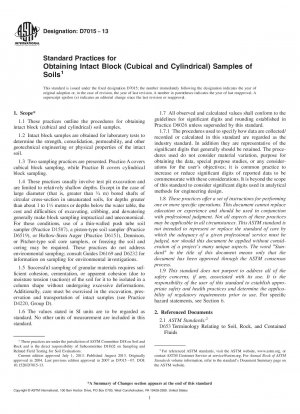ASTM D7015-13
Standard Practices for Obtaining Intact Block lpar;Cubical and Cylindricalrpar; Samples of Soils
- Standard No.
- ASTM D7015-13
- Release Date
- 2013
- Published By
- American Society for Testing and Materials (ASTM)
- Status
- Replace By
- ASTM D7015/D7015M-18
- Latest
- ASTM D7015/D7015M-18
- Scope
4.1 Intact block samples are suitable for laboratory tests where large-sized samples of intact material are required or where such sampling is more practical than conventional tube sampling (Practices D1587 and D6519), or both.
4.2 The intact block method of sampling is advantageous where the soil to be sampled is near the ground surface. It is the best available method for obtaining large intact samples of very stiff and brittle soils, partially cemented soils, and some soils containing coarse gravel.
4.3 Excavating a column of soil may relieve stresses in the soil and may result in some expansion of the soil and a corresponding decrease in its unit weight (density) or increase in sampling disturbance, or both. Usually the expansion is small in magnitude because of the shallow depth. Stress changes alone can cause enough disturbances in some soils to significantly alter their engineering properties.
4.4 The chain saw has proved advantageous in sampling difficult soils, which are blocky, slickensided, or materials containing alternating layers of hard and soft material.3 The chain saw uses a special carbide-tipped chain.4
Note 1—The quality of the result produced by this standard is dependent on the competence of the personnel performing it, and the suitability of the equipment and facilities used. Agencies that meet the criteria of Practice D3740 are generally considered capable of competent and objective sampling. Users of this standard are cautioned that compliance with Practice D3740 does not in itself assure reliable results. Reliable results depend on many factors; Practice D3740 provides a means of evaluating some of those factors.1.1 These practices outline the procedures for obtaining intact block (cubical and cylindrical) soil samples.
1.2 Intact block samples are obtained for laboratory tests to determine the strength, consolidation, permeability, and other geotechnical engineering or physical properties of the intact soil.
1.3 Two sampling practices are presented. Practice A covers cubical block sampling, while Practice B covers cylindrical block sampling.
1.4 These practices usually involve test pit excavation and are limited to relatively shallow depths. Except in the case of large diameter (that is, greater than 3/4 m) bored shafts of circular cross-section in unsaturated soils, for depths greater than about 1 to 11/2 metres or depths below the water table, the cost and difficulties of excavating, cribbing, and dewatering generally make block sampling impractical and uneconomical. For these conditions, use of a thin-walled push tube soil sampler (Practice D1587), a piston-type soil sampler (Practice D6519), or Hollow-Stem Auger (Practice D6151), Dennison, or Pitcher-type soil core samplers, or freezing the soil and coring may be required. These practices do not address environmental sampling; consult Guides D6169 and D6232 for information on sampling for environmental investigations.
1.5 Successful sampling of granular materials requires sufficient cohesion, cementation, or apparent cohesion (due to moisture tension (suction)) of the soil for it to be isolated in a......
ASTM D7015-13 Referenced Document
- ASTM D1587 Standard Practice for Thin-Walled Tube Sampling of Soils for Geotechnical Purposes
- ASTM D1785 Standard Specification for Poly(Vinyl Chloride) (PVC) Plastic Pipe, Schedules 40, 80, and 120
- ASTM D2488 Recommended Practice for Description Of Soils (Visual-Manual Procedure)
- ASTM D2937 Standard Test Method for Field Determination of Soil Density by the Pushing Cylinder Method*, 2024-04-20 Update
- ASTM D3740 Standard Practice for Minimum Requirements for Agencies Engaged in the Testing and/or Inspection of Soil and Rock as Used in Engineering Design and Construction
- ASTM D4220 Standard Practices for Preserving and Transporting Soil Samples
- ASTM D5434 Standard Guide for Field Logging of Subsurface Explorations of Soil and Rock
- ASTM D6026 Standard Practice for Using Significant Digits in Geotechnical Data
- ASTM D6151 Standard Practice for Using Hollow-Stem Augers for Geotechnical Exploration and Soil Sampling
- ASTM D6169 Standard Guide for Selection of Soil and Rock Sampling Devices Used With Drill Rigs for Environmental Investigations
- ASTM D6232 Standard Guide for Selection of Sampling Equipment for Waste and Contaminated Media Data Collection Activities
- ASTM D6519 Standard Practice for Sampling of Soil Using the Hydraulically Operated Stationary Piston Sampler*, 2024-04-20 Update
- ASTM D653 Standard Terminology Relating to Soil, Rock, and Contained Fluids
ASTM D7015-13 history
- 2018 ASTM D7015/D7015M-18 Standard Practices for Obtaining Intact Block (Cubical and Cylindrical) Samples of Soils
- 2013 ASTM D7015-13 Standard Practices for Obtaining Intact Block lpar;Cubical and Cylindricalrpar; Samples of Soils
- 2007 ASTM D7015-07 Standard Practices for Obtaining Intact Block (Cubical and Cylindrical) Samples of Soils
- 2004 ASTM D7015-04 Standard Practices for Obtaining Undisturbed Block (Cubical and Cylindrical) Samples of Soils

Copyright ©2024 All Rights Reserved